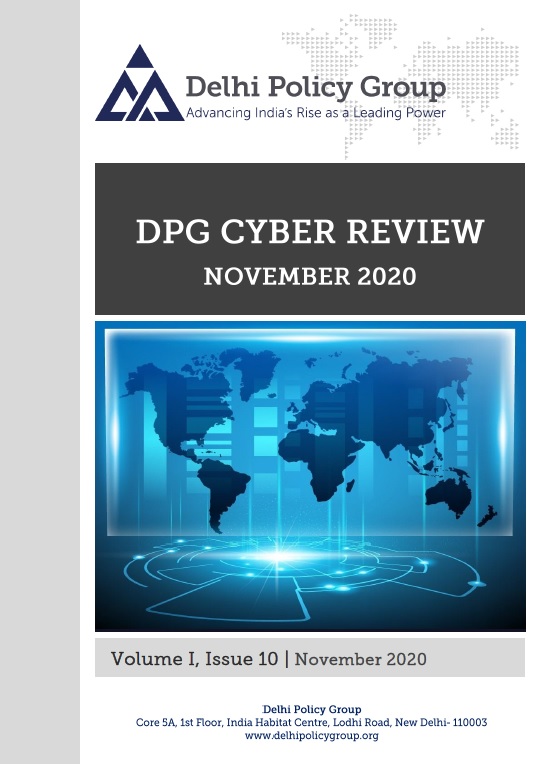Volume 1, Issue 10
Date: December 03, 2020
In recent months, there has been an increase in ransomware attacks on Indian industries, mainly pharmaceutical companies. These attacks have mostly emanated from China and Pakistan, mirroring prevailing geopolitical tensions. A recent survey has predicted that nation-state attacks will be the biggest concern for 2021. To combat these challenges, the Indian establishment is working out strategies, including banning mobile apps that are engaged in activities prejudicial to national security.
Technological capabilities being the key to secure cyber space, the Prime Minister has exhorted young talent in the country to create robust cyber security solutions to protect data. National technological capabilities have received a boost with the launch of Indian radar imaging satellite EOS-01, equipped with synthetic aperture radar that can take pictures in all weather conditions.
The indigenously developed Indian Regional Navigation Satellite System (IRNSS) received global recognition by being recognised as a component of the World-Wide Radio Navigation System from the International Maritime Organisation. In addition, India's radio interface technology (5Gi) has been evaluated by ITU and deemed to be conforming to the global 5G standard. Further, the Indian supercomputer ‘Param Siddhi’ achieved the global ranking of 63 among the top 500 most powerful non-distributed computer systems in the world.
Recognising the criticality of building an indigenous and secured telecom infrastructure, the government has included telecom & networking products as part of the Production-Linked Incentive (PLI) scheme which is designed to provide budgetary support to 10 key sectors. This is in addition to the already notified PLI scheme in mobile manufacturing.
Global cyber space continues to be affected by ransom-driven ‘denial of service’ attacks by several hacker groups like Fancy Bear, Cozy Bear and Lazarus. These groups are suspected to be associated with particular nation states. Global and bilateral collaboration along with regulatory norms are considered essential to deal with this menace. The US National Security Commission on Artificial Intelligence has proposed a formal alliance with India and other nations in the Indo-Pacific region to develop an overarching Indo-Pacific security strategy focused on emerging technologies.
On the regulatory side, European Union lawmakers have proposed a new set of rules for exporting dual use products and technologies, including cyber-surveillance tools. Similarly, a new telecommunications (security) Bill has been introduced in the British Parliament proposing to block high-risk equipment suppliers and tighten security requirements for new high-speed fibre optic and 5G wireless networks.
At the virtual 15th G20 summit on November 21, the Prime Minister proposed a global index for the post-Corona world, based on talent, technology, transparency and trusteeship. He also suggested the creation of a G20 Virtual Secretariat as a follow up and documentation repository. Similar views were also echoed by India at the 15th annual Meeting of the Internet Governance Forum (IGF) organised by the United Nations, which recognised the world’s increased reliance on the internet during the Covid-19 pandemic and called for digital inclusion to build a strong recovery.
Technological capabilities being the key to secure cyber space, the Prime Minister has exhorted young talent in the country to create robust cyber security solutions to protect data. National technological capabilities have received a boost with the launch of Indian radar imaging satellite EOS-01, equipped with synthetic aperture radar that can take pictures in all weather conditions.
The indigenously developed Indian Regional Navigation Satellite System (IRNSS) received global recognition by being recognised as a component of the World-Wide Radio Navigation System from the International Maritime Organisation. In addition, India's radio interface technology (5Gi) has been evaluated by ITU and deemed to be conforming to the global 5G standard. Further, the Indian supercomputer ‘Param Siddhi’ achieved the global ranking of 63 among the top 500 most powerful non-distributed computer systems in the world.
Recognising the criticality of building an indigenous and secured telecom infrastructure, the government has included telecom & networking products as part of the Production-Linked Incentive (PLI) scheme which is designed to provide budgetary support to 10 key sectors. This is in addition to the already notified PLI scheme in mobile manufacturing.
Global cyber space continues to be affected by ransom-driven ‘denial of service’ attacks by several hacker groups like Fancy Bear, Cozy Bear and Lazarus. These groups are suspected to be associated with particular nation states. Global and bilateral collaboration along with regulatory norms are considered essential to deal with this menace. The US National Security Commission on Artificial Intelligence has proposed a formal alliance with India and other nations in the Indo-Pacific region to develop an overarching Indo-Pacific security strategy focused on emerging technologies.
On the regulatory side, European Union lawmakers have proposed a new set of rules for exporting dual use products and technologies, including cyber-surveillance tools. Similarly, a new telecommunications (security) Bill has been introduced in the British Parliament proposing to block high-risk equipment suppliers and tighten security requirements for new high-speed fibre optic and 5G wireless networks.
At the virtual 15th G20 summit on November 21, the Prime Minister proposed a global index for the post-Corona world, based on talent, technology, transparency and trusteeship. He also suggested the creation of a G20 Virtual Secretariat as a follow up and documentation repository. Similar views were also echoed by India at the 15th annual Meeting of the Internet Governance Forum (IGF) organised by the United Nations, which recognised the world’s increased reliance on the internet during the Covid-19 pandemic and called for digital inclusion to build a strong recovery.



